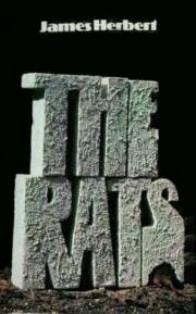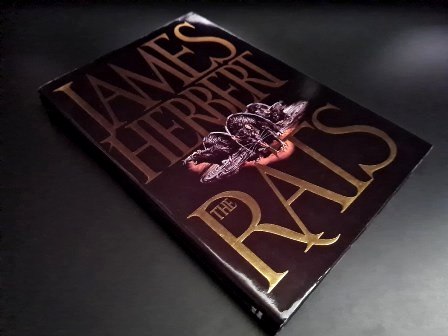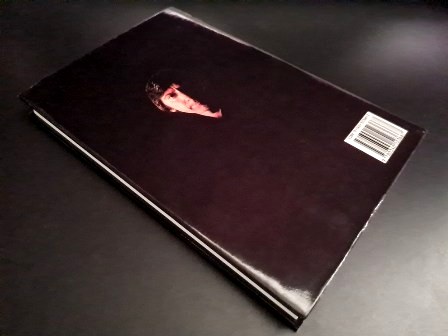
First published back in January of 1974, James Herbert’s debut novel ‘The Rats’ created quite an impact in the world of horror literature with its ground-breaking no-holds-barred approach to graphic scenes of explicit gore and over-the-top violence. The novel would later be dubbed the founding title that created the subgenre appropriately titled ‘splatterpunk’, whilst crowning Herbert the godfather of the subgenre and propelling him to instant fame. ‘The Rats’ also set in motion what would soon become a bombardment of similarly themed pulp horror novels, comprising of a whole host of different animals and creatures on the rampage.
Herbert later admitted that the story was merely written as a hobby, until the manuscript was typed-up by his wife, Eileen Herbert, and
sent off to nine separate publishers. New English Library subsequently snapped
up the title, and so Herbert’s career in horror writing was
launched.
DLS Synopsis:
It was during a normal day in the East London secondary school that the art teacher, Mr Harris, noticed that one of his students had a wounded and bandaged hand. Concerned for the well-being of the pupil, Harris is informed that the wound was inflicted by a savage rat.
Elsewhere in London a mother’s baby daughter and their dog are attacked by a horde of giant rats. The baby and dog are killed in the attack; however the distraught mother suffers only a number of bites and is taken in to hospital. Harris arrives at the same hospital with the wounded student in tow and whilst there learns about the sudden influx in rat related attacks across the city of London.
Before long, a group of squabbling vagrants fall victim to the vicious rats as the rodents’ numbers and confidence increases. And then the situation goes from bad to worse when Harris is informed by the Minister of Health that the student he took into the hospital with the rat bite later died from the wound. It appears that the rats are carrying some form of disease that kills those infected with it within just twenty-four hours. However, to avoid an outright panic, Harris is told that this information must be kept secret from the general public.
Reeling from the news, Harris, together with a local exterminator, make their way down to the canals where they believe the student was attacked, in the hope of finding some of these giant rats. And they’re not disappointed. However, whilst Harris contacts the authorities, the exterminator attempts to follow the rats, only to be viciously killed in doing so.
All of a sudden, the sporadic rat attacks have now become an all-out epidemic; with growing numbers of the general public suffering from vicious rat attacks across London. Furthermore, the attacks are becoming bolder, involving larger numbers of casualties in each case.
But none of the attacks would compare to the horror that would later become known as ‘Black Monday’. An attack which saw swarms of the rats rampaging through the London underground, whilst a further swarm simultaneously hit the secondary school where Harris himself taught. And with the city of London offering up the perfect environment for them to inhabit, suddenly nowhere within the vast concrete jungle is safe from the threat of the giant black rats...
DLS Review:
From the absolute outset, Herbert dives in with an unashamedly gory opener, as the very first person to be introduced (an alcoholic vagrant) falls victim to the giant black rats. And to properly set the novel off on the right foot, Herbert ladles in copious amounts of blood-spill to really set in motion the overtly graphic nature that will be maintained throughout the novel.
Herbert’s concoction of excessive violence depicted in such a graphic nature, mixed with a healthy smattering of sex, together with a plot that races along at a neck-breaking pace; is what will ultimately come to define a whole new style of horror novel.
It has to be noted that the characterisation really takes a backseat in the novel; with precedence instead given to an unrelenting action-packed storyline that bombards the reader with scene after scene of extreme violence and gratuitous bloodshed. No attempt is made to really delve into the emotional impact of these devastating attacks upon their victims. Instead, Herbert simply hits the reader again with another equally horrific assault; never once letting the reader fully recover from the last attack.
On numerous occasions, the build-up to another inevitable rat attack seems painfully obvious for the reader, with the next scene set without a thought for any element of surprise. However, where this may have been a negative aspect, instead the sheer suspense of the impending attack works much more in the novel’s favour, keeping the reader perched on the very edge of their seat throughout the length of the novel.
The tale sports an underlying commentary around the government’s seemingly impartial view towards the well-being of the underclass, reflected in the delayed reaction towards the epidemic when it first hits the previously neglected slums of post WWII East London. And this is in no way seems either forced or cliqued, but simply adds another hard and gritty layer to the novel.
It has to be said that for the impact on the horror community alone this novel is nothing short of an absolute classic piece of horror literature. Even in the face of countless attempts at recreating the menace that is unleashed in this novel (hundreds of such novels saturated the market following the success of ‘The Rats’), no author has managed to produce anything that comes even remotely close to the genius that is ‘The Rats’. Not only did the novel create the subgenre of splatterpunk, but it set the bar at which any novels would later be judged.
Interestingly, the prolific horror writer Guy N Smith
supposedly submitted the idea for a ‘rats on the rampage’ novel,
but was narrowly beaten to the post by Herbert. And Herbert later revealed that the inspiration for his novel came from watching Tod Browning’s 1931 film
adaptation of Dracula, specifically, from Renfield’s vivid recount of a
nightmare involving a swarm of rats bowing to the figure of Dracula.
This trigger, combined with Herbert’s own upbringing in the East End of
London where large rats infested the post blitz streets, created the
inspiration for what would later become an all-time classic horror novel.
Two further sequels followed on from the novel - ‘Lair’ (1979) and ‘Domain’ (1984) as well as a graphic novel entitled ‘The City’ (1994). The story was later somewhat loosely adapted into the Canadian film ‘Deadly Eyes’ (1982) that was directed by Robert Clouse. Apart from the general concept of ‘rats on the rampage’, the film shares little to no other similarities to the book. A computer game based on the novel was also released in 1985 for the Commodore 64 and ZX Spectrum.
The novel runs for a total of 175 pages.
© DLS Reviews
Other ‘Rats’ instalments:









